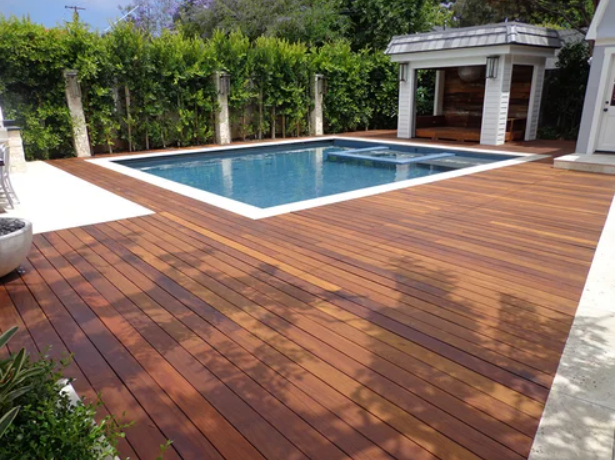Ipe wood, also known as Brazilian walnut, has gained significant popularity in the world of construction and decking due to its exceptional durability, beauty, and versatility. This exotic hardwood is native to Central and South America and is renowned for its rich color, strength, and natural resistance to weathering and pests. In this article, we’ll explore the key characteristics, benefits, and uses of Ipe wood, as well as some important considerations when working with it.
1. What is Ipe Wood?
Ipe wood (pronounced “ee-pay”) is a tropical hardwood harvested from the Tabebuia tree, which grows in the rainforests of Brazil and other parts of Latin America. Its botanical name is Handroanthus spp., and it belongs to the Bignoniaceae family. Ipe is often called the “ironwood” because of its extreme density and hardness, making it one of the most durable natural woods available.
2. Characteristics of Ipe Wood
- Durability: Ipe wood is renowned for its exceptional hardness and resistance to wear. It is over five times harder than pine, making it ideal for high-traffic areas such as decks and walkways.
- Natural Resistance: Ipe naturally resists rot, decay, insects, and mold. It has a high concentration of natural oils and dense fibers that repel termites and other pests.
- Fire Rating: Unlike most woods, Ipe has a fire rating similar to steel and concrete, which adds to its appeal for outdoor projects where fire safety is a concern.
- Appearance: Ipe wood features a beautiful, rich color range from olive-brown to reddish-brown, with fine grain and occasional dark streaks. The wood’s color can be maintained with oiling or allowed to weather naturally to a silver-gray patina.
- Density: Its high density makes Ipe extremely heavy and difficult to cut without specialized tools. While this adds to its strength, it also requires more effort during installation.
3. Uses of Ipe Wood
Ipe is prized for its versatility and is used in a variety of applications, both indoors and outdoors. Some of the most common uses include:
- Decking: Ipe is widely used for outdoor decking because of its natural resistance to moisture, insects, and wear. Ipe decks are known to last up to 40 years with minimal maintenance.
- Siding & Cladding: Ipe is often used for exterior siding and cladding, offering a luxurious look while protecting buildings from weather damage.
- Furniture: High-end outdoor furniture often uses Ipe for its durability and sleek appearance.
- Fencing: Ipe’s resistance to decay makes it ideal for fences that can withstand exposure to the elements.
- Marine Construction: Ipe is commonly used in docks, boardwalks, and bridges due to its ability to endure constant exposure to water without rotting.
4. Benefits of Ipe Wood
- Longevity: Ipe is incredibly long-lasting, outlasting many other hardwoods. Properly maintained, Ipe wood can last over 50 years.
- Sustainability: While Ipe is a rainforest wood, sustainable harvesting practices and certifications like FSC (Forest Stewardship Council) ensure that Ipe is sourced responsibly.
- Low Maintenance: Ipe wood requires minimal maintenance compared to other woods. An annual application of oil can help retain its color, but it is otherwise naturally weather-resistant.
- Eco-Friendly Alternative: Ipe is often chosen as an eco-friendly alternative to chemically treated woods because of its natural resistance to pests and decay.
5. Considerations When Using Ipe Wood
- Cost: Ipe wood is considered one of the most expensive woods available due to its scarcity and high demand. However, its longevity and low maintenance requirements can justify the initial cost.
- Installation: Due to its density and hardness, Ipe is challenging to work with and requires carbide-tipped tools and pre-drilling for screws.
- Environmental Concerns: While Ipe is a renewable resource, it’s important to ensure that the wood you are purchasing is sustainably harvested. The depletion of rainforests remains a concern, so purchasing FSC-certified Ipe wood is crucial.
6. Maintenance of Ipe Wood
To maintain the vibrant color of Ipe wood, it’s recommended to apply a UV-protective oil finish once or twice a year. However, if you prefer the silver-gray patina, you can allow the wood to weather naturally without treatment. Cleaning Ipe decks or furniture with a mild soap and water solution will help maintain their appearance over time.
7. Conclusion
Ipe wood offers a unique combination of beauty, strength, and durability, making it an ideal choice for outdoor projects like decking, siding, and furniture. While its higher price point and challenging installation process may deter some, the long-term benefits of Ipe wood far outweigh these considerations. With proper care and maintenance, Ipe wood can be a worthwhile investment that enhances the aesthetics and longevity of any outdoor space.
